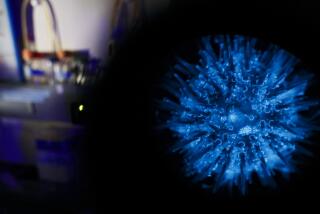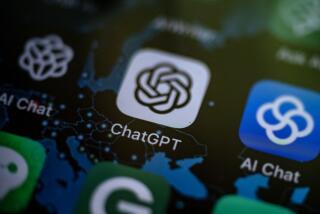One Tiny Step for Bionic Mankind
Researchers at Stanford University have brought about a unique marriage between computer chips and living cells that could greatly accelerate everything from tests for new drugs to screening for diseases such as leukemia.
The basic living element in every organism is the cell. Humans have at least 100 trillion of them, all designed to carry out various bodily functions. Each cell is a complex bag of enzymes and chemicals surrounded by a spherical membrane, and how a cell reproduces and works with other cells determines how efficiently the organism performs.
Scientists have struggled for years to understand the cell and especially the membrane that seems to control most of the crucial functions, but they have been hampered by the difficulty of growing cells in a laboratory culture for research.
A decade ago, Stanford researchers developed artificial membranes that were so like the real thing that living cells could be tricked into attaching themselves to them.
Two years ago, graduate student Jay T. Groves learned something interesting when he pulled a pair of tweezers through one of the artificial membranes. The parts separated permanently. He also found that he could manipulate the different parts by applying an electrical current.
About that time, Nick Ulman, an electrical engineer, joined Groves’ research group, headed by chemistry professor Steven G. Boxer. Ulman brought with him an understanding of microelectronics.
The researchers discovered that the electric field generated by a tiny microchip could be used to separate the artificial membrane into tiny squares, which they called “corrals.” The corrals were so small that millions occupied an area no bigger than a fingernail.
That gave the researchers something they had never had before: a means of isolating, cataloging and manipulating millions of cell membranes simultaneously.
“It’s a little bit like having a parking lot with assigned spaces,” Boxer says. If you leave your car in an unmarked parking lot at the airport, he says, you may be lucky to find it again. But if each parking space has a number, it becomes much simpler.
“Ultimately, you can say I’ve got a Ferrari in spot 2A, and I’ve got a Volkswagen over in space 3D,” Boxer says.
Similarly, living cells can be “tricked” into attaching themselves to individual membranes. That is done by modifying the surface of each membrane.
“If you wax a car, after you wax it, water beads up on the surface,” Boxer says. “Before waxing, the water just runs off. That’s an example of modifying the properties of the surface such that water associates differently with the surface.”
One potential use is for cell screening for leukemia patients. Some of the membranes on the chip could be “seeded” with proteins that bind to different kinds of cells. By flooding a glass plate embedded with chips with blood from the patient, the cells would attach themselves to designated areas, thus revealing how many cells of different types are present, and possibly even how well they are performing.
Joseph A. Zasadzinski, professor of chemical engineering at UC Santa Barbara, who has analyzed the Stanford research, sees many potential applications.
It could pave the way for a pharmaceutical researcher to “try 50 million different things” at the same time, Zasadzinski says.
“Right now, you grow cells in culture and you see which ones die, and that’s very slow. Here you can imagine 20,000 little plates in a square inch, and each one of them you can tweak a slightly different way.”
It could greatly increase the rate of testing for new drugs for viruses, he says, because the experiments could be repeated millions of times in a tightly controlled and manipulable environment.
Others see it leading to a test for AIDS in which thousands of blood tests could be conducted in the time it now takes to do just one.
The heart of the system is the computer chip.
“That’s where the ultimate power of this comes in,” Boxer says. “The same technology that’s used to make integrated circuits, computer chips, is also being used to design a biocompatible surface.”
That has led to a bit of unwelcome fallout, he adds. The researchers are constantly asked if they are on the road to the ultimate marriage between computers and living cells--the bionic man.
Boxer flinches at the suggestion. This is such a tiny step, he says, that it’s ludicrous to think of it in those terms. Still, some see this as one more step toward creating computer-based biological systems.
“If you can optimize this, you can get a nice bio-sensor out of it,” Zasadzinski says. “But it would be hard to imagine any sort of bionic man for an awful long time.”
He says he is more worried about “that sheep in England.”
“That’s scary,” he says.
*
Lee Dye can be reached via e-mail at leedye@compuserve.com






